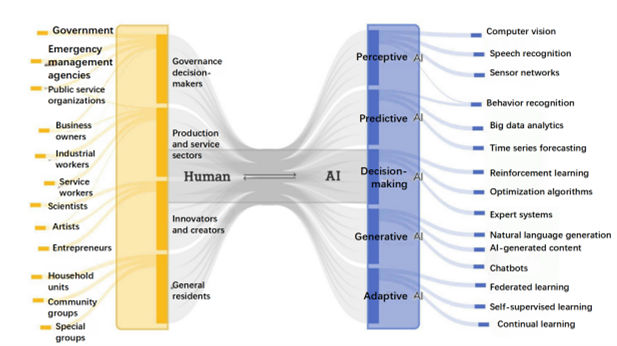

In today's field of design and planning, the integration model of HAI (Human + AI) often first leads people to focus on the potential replacement relationship between AI and designers. Designers who were once full of confidence now find themselves grappling with self-doubt: will the design work they are engaged in today be replaced by AI tomorrow? Meanwhile, those designers who were previously less strong in creative innovation have begun to wonder whether they can leverage AI's powerful capabilities to make up for their shortcomings in creativity.
Through several years of simulated practice and exploration, I believe there is an even more critical question: what type of AI is suited to what type of problem. By leveraging the competitive mechanisms among different AI systems, it becomes possible to provide designers with the most appropriate AI-assisted tools. Only recently have designers and planners begun to witness an ecological competition among AI communities, gradually moving beyond the one-dimensional thinking of relying solely on AI or solely on human capabilities.
Today, we have all experienced firsthand that different AI tools - such as Doubao, Mita, ChatGPT, DeepSeek, Kimi, and ERNIE Bot - each possess unique functions and strengths. Likewise, every designer has distinct characteristics, and more importantly, there are significant differences in their ability to focus on and define problems. When using the same type of AI tool, the way a designer formulates questions becomes a key factor in determining the current and future heights and depths of design work. In turn, this places higher demands and challenges on designers' and planners' intellectual depth, logical thinking, and language expression abilities.
All of the above essentially constitute three types of relationships in the HAI Ecosystem of Urban Design and Planning:
1 The characteristics and competitive-cooperative dynamics among different AI communities;
2 The differences among designers and planners in terms of intellectual logic and the ability to precisely distill problems;
3 The complex ecological relationship between AI communities and the designer community.
We can visualize the process of delving into the HAI model for design and planning through an H-shaped diagram: the right side represents the AI communities, the left side represents the traditional communities of designers and planners, and the middle is filled with countless arcs full of infinite possibilities. These arcs symbolize the complex and diverse relationships of collaboration, complementarity, and competition between AI and planners. Within this evolving landscape, many blank spaces remain, calling for greater investment of effort, precise thinking, and deeper exploration in the future.

Reflection 1: How should competition and cooperation among AI ecosystems be realized, and how will they evolve? In our research process, the number of AI tools we have encountered has grown from the initial 1,000 to 3,000, and now to over 16,500. As AI technologies evolve at an astonishing pace, new AI tools emerge every day. However, in the actual practice of design and planning, it is neither practical nor advisable to use a large number of AI tools indiscriminately for a specific task. Otherwise, one may easily lose direction in the complex and ever-growing "ecosystem" of AI tools. Therefore, it is essential to filter and select only a few AI tools that are most suitable for each specific stage of work through practical experience. After multiple rounds of selection, we eventually established a specialized toolkit consisting of 60 precisely matched AI tools. This toolkit continues to be iteratively updated as technologies advance.
Reflection 2: If used appropriately, AI can become a powerful assistant for designers, supporting key tasks such as language organization and image creation at specific stages of the design process. However, the prerequisite for AI to fulfill this role lies in the designer’s ability to formulate precise questions. We must constantly reflect: will excellent AI assistants naturally gravitate toward excellent lead designers? When designers fail to pose precise questions and clearly articulate their needs, will these "outstanding assistants" eventually "leave the team"? Today, it is not uncommon to observe a phenomenon of AI "producing lengthy but useless responses" - a situation often rooted in the user's inability to grasp key points and raise core questions with clear instructions. Therefore, in the current field of design and planning, an important question arises: how can designers and planners learn to formulate the most concise and essential questions and requirements to fully harness AI's potential? This is a crucial issue that merits deep exploration.
Reflection 3: AI carries the risk of being misled by humans and may even exhibit "dishonest" behavior. At times, users force AI to answer questions about matters that do not exist in the real world, demand retrieval of non-existent facts, or explore relationships between things that are logically unrelated. Under such pressure, AI may reluctantly generate large amounts of fabricated information. At its root, this phenomenon is closely tied to improper questioning by users.
We must seriously acknowledge the possibility of such "bullying" behavior between humans and AI, and reflect on how to build a partnership characterized by mutual trust, mutual care, and mutual respect. This is essential for promoting the healthy development of AI technologies and fostering harmonious coexistence between humans and AI.
Although human-AI interaction is still at an early threshold-crossing stage, we have already witnessed the arrival of a new era. We have stepped beyond the traditional age of design and planning; and although design has not yet been fully established as a new educational system, we have already initiated the creation of a new era.
These reflections offer much for readers to observe and experience. In future issues of the Weekly, we will invite more designers and planners to engage in deeper analysis, research, and reflection.
Source:https://mp.weixin.qq.com/s/bdaOeTTmOofZ_hli7jEVSg